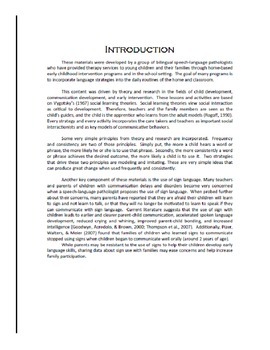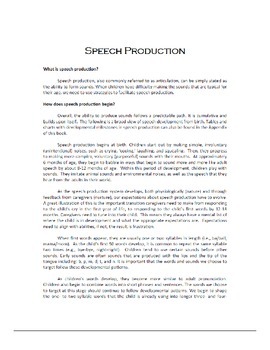Teaching Children How To: Expand Phrases
Bilinguistics
684 Followers
Grade Levels
PreK - 1st, Staff
Resource Type
Formats Included
- PDF
Pages
17 pages
Bilinguistics
684 Followers
Description
The magic behind increasing communication is choosing one major goal (e.g. following directions) and focusing on improving this communication during one routine (e.g. morning calendar). Teacher Children to Communicate series provides simple instructions on how to increase students communication in a small amount of time.
Parent involvement is critical so each packet includes parent-friendly suggestions so that parents and teachers are on the same page. Early language development has been show to increase when signs are incorporated into the routine. We have included 6 signs related to each communication objective. Best of all, the parent materials and classroom suggestions are also in Spanish so that our diverse families are rapidly able to assist you in the process of increasing their child’s language.
These materials were developed by a group of bilingual speech-language pathologists who have provided therapy services to young children and their families through home-based early childhood intervention programs and in the school setting. The goal of many programs is to incorporate language strategies into the daily routines of the home and classroom.
This content was driven by theory and research in the fields of child development, communication development, and early intervention. These lessons and activities are based on Vygotsky’s (1967) social learning theories. Social learning theories view social interaction as critical to development. Therefore, teachers and the family members are seen as the child’s guides, and the child is the apprentice who learns from the adult models (Rogoff, 1990). Every strategy and every activity incorporates the care takers and teachers as important social interactionists and as key models of communicative behaviors.
Some very simple principles from theory and research are incorporated. Frequency and consistency are two of those principles. Simply put, the more a child hears a word or phrase, the more likely he or she is to use that phrase. Secondly, the more consistently a word or phrase achieves the desired outcome, the more likely a child is to use it. Two strategies that drive these two principles are modeling and imitating. These are very simple ideas that can produce great change when used frequently and consistently.
Another key component of these materials is the use of sign language. Many teachers and parents of children with communication delays and disorders become very concerned when a speech-language pathologist proposes the use of sign language. When probed further about their concerns, many parents have reported that they are afraid their children will learn to sign and not learn to talk, or that they will no longer be motivated to learn to speak if they can communicate with sign language. Current literature suggests that the use of sign with children leads to earlier and clearer parent-child communication, accelerated spoken language development, reduced crying and whining, improved parent-child bonding, and increased intelligence (Goodwyn, Acredolo, & Brown, 2000; Thompson et al., 2007). Additionally, Pizer, Walters, & Meier (2007) found that families of children who learned signs to communicate stopped using signs when children began to communicate well orally (around 2 years of age).
While parents may be resistant to the use of signs to help their children develop early language skills, sharing data about sign use with families may ease concerns and help increase family participation.
Expand Phrases
Increase the amount your student says by using Cloze Techniques
Cloze techniques involve giving a child the first part of a sentence (e.g. “Put on your ______”), in an attempt to encourage the child to produce the missing word (e.g. “shoes”) Often, parents and teachers may watch a service provider use this technique successfully, but then have less success on their own. What they may not have picked up on is the structure that has been created in order to elicit a specific word. Cloze techniques are not merely fill-in-the-blanks, but are the process of guiding a child to a successful response. This is achieved by creating a routine that has an order to it and that happens frequently.
Parent involvement is critical so each packet includes parent-friendly suggestions so that parents and teachers are on the same page. Early language development has been show to increase when signs are incorporated into the routine. We have included 6 signs related to each communication objective. Best of all, the parent materials and classroom suggestions are also in Spanish so that our diverse families are rapidly able to assist you in the process of increasing their child’s language.
These materials were developed by a group of bilingual speech-language pathologists who have provided therapy services to young children and their families through home-based early childhood intervention programs and in the school setting. The goal of many programs is to incorporate language strategies into the daily routines of the home and classroom.
This content was driven by theory and research in the fields of child development, communication development, and early intervention. These lessons and activities are based on Vygotsky’s (1967) social learning theories. Social learning theories view social interaction as critical to development. Therefore, teachers and the family members are seen as the child’s guides, and the child is the apprentice who learns from the adult models (Rogoff, 1990). Every strategy and every activity incorporates the care takers and teachers as important social interactionists and as key models of communicative behaviors.
Some very simple principles from theory and research are incorporated. Frequency and consistency are two of those principles. Simply put, the more a child hears a word or phrase, the more likely he or she is to use that phrase. Secondly, the more consistently a word or phrase achieves the desired outcome, the more likely a child is to use it. Two strategies that drive these two principles are modeling and imitating. These are very simple ideas that can produce great change when used frequently and consistently.
Another key component of these materials is the use of sign language. Many teachers and parents of children with communication delays and disorders become very concerned when a speech-language pathologist proposes the use of sign language. When probed further about their concerns, many parents have reported that they are afraid their children will learn to sign and not learn to talk, or that they will no longer be motivated to learn to speak if they can communicate with sign language. Current literature suggests that the use of sign with children leads to earlier and clearer parent-child communication, accelerated spoken language development, reduced crying and whining, improved parent-child bonding, and increased intelligence (Goodwyn, Acredolo, & Brown, 2000; Thompson et al., 2007). Additionally, Pizer, Walters, & Meier (2007) found that families of children who learned signs to communicate stopped using signs when children began to communicate well orally (around 2 years of age).
While parents may be resistant to the use of signs to help their children develop early language skills, sharing data about sign use with families may ease concerns and help increase family participation.
Expand Phrases
Increase the amount your student says by using Cloze Techniques
Cloze techniques involve giving a child the first part of a sentence (e.g. “Put on your ______”), in an attempt to encourage the child to produce the missing word (e.g. “shoes”) Often, parents and teachers may watch a service provider use this technique successfully, but then have less success on their own. What they may not have picked up on is the structure that has been created in order to elicit a specific word. Cloze techniques are not merely fill-in-the-blanks, but are the process of guiding a child to a successful response. This is achieved by creating a routine that has an order to it and that happens frequently.
Total Pages
17 pages
Answer Key
N/A
Teaching Duration
N/A
Report this resource to TPT
Reported resources will be reviewed by our team. Report this resource to let us know if this resource violates TPT’s content guidelines.





